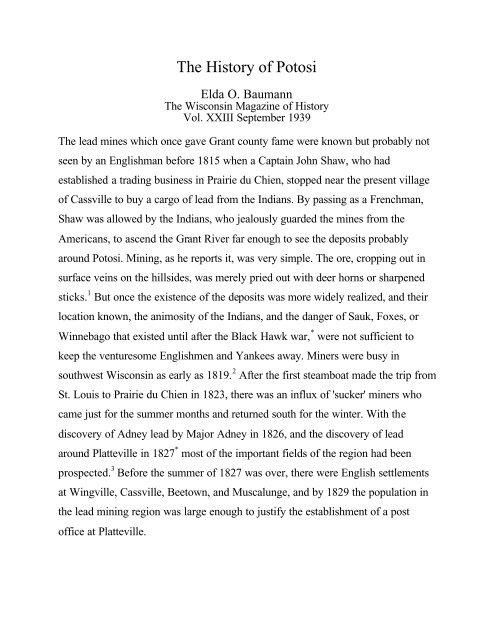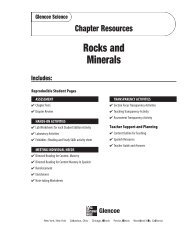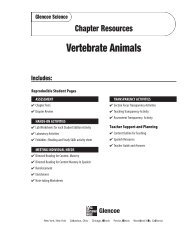The History of Potosi good copy - Potosi... A Community of Character
The History of Potosi good copy - Potosi... A Community of Character
The History of Potosi good copy - Potosi... A Community of Character
Create successful ePaper yourself
Turn your PDF publications into a flip-book with our unique Google optimized e-Paper software.
<strong>The</strong> <strong>History</strong> <strong>of</strong> <strong>Potosi</strong><br />
Elda O. Baumann<br />
<strong>The</strong> Wisconsin Magazine <strong>of</strong> <strong>History</strong><br />
Vol. XXIII September 1939<br />
<strong>The</strong> lead mines which once gave Grant county fame were known but probably not<br />
seen by an Englishman before 1815 when a Captain John Shaw, who had<br />
established a trading business in Prairie du Chien, stopped near the present village<br />
<strong>of</strong> Cassville to buy a cargo <strong>of</strong> lead from the Indians. By passing as a Frenchman,<br />
Shaw was allowed by the Indians, who jealously guarded the mines from the<br />
Americans, to ascend the Grant River far enough to see the deposits probably<br />
around <strong>Potosi</strong>. Mining, as he reports it, was very simple. <strong>The</strong> ore, cropping out in<br />
surface veins on the hillsides, was merely pried out with deer horns or sharpened<br />
sticks. 1 But once the existence <strong>of</strong> the deposits was more widely realized, and their<br />
location known, the animosity <strong>of</strong> the Indians, and the danger <strong>of</strong> Sauk, Foxes, or<br />
Winnebago that existed until after the Black Hawk war, * were not sufficient to<br />
keep the venturesome Englishmen and Yankees away. Miners were busy in<br />
southwest Wisconsin as early as 1819. 2 After the first steamboat made the trip from<br />
St. Louis to Prairie du Chien in 1823, there was an influx <strong>of</strong> 'sucker' miners who<br />
came just for the summer months and returned south for the winter. With the<br />
discovery <strong>of</strong> Adney lead by Major Adney in 1826, and the discovery <strong>of</strong> lead<br />
around Platteville in 1827 * most <strong>of</strong> the important fields <strong>of</strong> the region had been<br />
prospected. 3 Before the summer <strong>of</strong> 1827 was over, there were English settlements<br />
at Wingville, Cassville, Beetown, and Muscalunge, and by 1829 the population in<br />
the lead mining region was large enough to justify the establishment <strong>of</strong> a post<br />
<strong>of</strong>fice at Platteville.
In 1829, also, float was found in what is now <strong>Potosi</strong> 4 and a cabin, the first in that<br />
vicinity, was built by Thomas Hymer. Because <strong>of</strong> Indian troubles, however, he did<br />
not stay; * and the development <strong>of</strong> these rich deposits did not really begin until the<br />
end <strong>of</strong> the Black Hawk war in 1833, with the discovery <strong>of</strong> the famous <strong>Potosi</strong> cave<br />
by Willis St. John and Isaac Whitaker, the first permanent settlers <strong>of</strong> the town. 5<br />
Very shortly thereafter, in the same year, a group <strong>of</strong> English miners from Galena,<br />
about sixty in number, came and formed a camp in the Hollow. To guard against<br />
possible Indian troubles, they built a blockhouse in which they all gathered at<br />
night, after the day's mining. *<br />
Snake Hollow, as the town so begun was at first called, lies about fifteen miles<br />
from the southern boundary <strong>of</strong> Wisconsin, and two or three miles east <strong>of</strong> the<br />
Mississippi river. It runs along a winding valley for about three miles---a valley so<br />
narrow that there is room for only one street in the town. In the 1830's, three other<br />
towns sprang up between Snake Hollow and the Mississippi: Lafayette, Van<br />
Buren, Osceola. <strong>The</strong> last named town was very short-lived, but between the other<br />
two and Snake Hollow there existed great rivalry all through the decade, until they<br />
finally consolidated in 1839, with the head <strong>of</strong> Snake Hollow as the <strong>of</strong>ficial site <strong>of</strong><br />
the town, and under the <strong>of</strong>ficial name <strong>of</strong> <strong>Potosi</strong>. 6 No accounts <strong>of</strong> the town venture<br />
an explanation <strong>of</strong> this name, but as very many <strong>of</strong> the early settlers were miners<br />
from Missouri or had spent some time there, it seems reasonable to suppose that it<br />
was named after <strong>Potosi</strong>, Missouri, a mining town which itself was named after the<br />
mining province <strong>of</strong> <strong>Potosi</strong>, Mexico.
So closely connected with <strong>Potosi</strong> that it is impossible to keep their records apart,<br />
are three other settlements a mile and a half to two miles east: British Hollow,<br />
settled almost entirely by English from Cornwall and Wales; Rockville; and Dutch<br />
Hollow, settled mostly by Germans. In the whole district, mining was <strong>of</strong> course the<br />
chief occupation. By 1834 Willis St. John had established the first smelter, and by<br />
1840 there had been seven more built in and around <strong>Potosi</strong>. 7 Immigrants poured so<br />
steadily into the region that by 1841 <strong>Potosi</strong> was one <strong>of</strong> the first two towns <strong>of</strong> Grant<br />
county to be incorporated. * By 1845 it was the largest town in the western part <strong>of</strong><br />
the state, and the most feared rival <strong>of</strong> Galena and Dubuque, both <strong>of</strong> which<br />
employed runners to divert trade from there. For the river towns and trading posts<br />
up as far as Fort Snelling laid in supplies at <strong>Potosi</strong>, as did the lumbermen from the<br />
Kickapoo and Wisconsin rivers, surveyors from Dubuque and the Mineral Point<br />
land <strong>of</strong>fices, and hundreds <strong>of</strong> teamsters from Illinois and Missouri. Mining was<br />
still the main occupation, but other business flourished also. <strong>The</strong>re were in 1845, 8<br />
general stores, 2 drug stores, 1 clothing store, 1 hardware store, 4 cabinet shops, 1<br />
confectionery, 4 smelting furnaces, 6 saloons, 1 tenpin alley, 4 blacksmith shops, 1<br />
chair factory, 2 brick yards, 1 tanning yard, 1 tanning mill, 2 livery stables, 2 bake<br />
shops, 3 shoe shops, 2 wagon shops, 3 hotels, 2 barber shops, 2 tailors, 2 tinners, 2<br />
painters, 25 joiners, 12 brick and stone masons, 3 physicians, 1 jeweler, and 1<br />
milliner. <strong>The</strong> town had its own warehouse at the landing on Grant slough, which<br />
was still navigable, 8 its own brewery, 9 and its own newspaper, the <strong>Potosi</strong> Republic,<br />
a weekly folio <strong>of</strong> seven columns, politically Democratic. It had two large livery<br />
stables which ran a regular passenger and mail service between <strong>Potosi</strong> and Galena;<br />
and so heavy was the passenger traffic that the four-horse, rockaway coaches were<br />
usually not only filled, but carried riders on the top and on the boot <strong>of</strong> the coach.<br />
Its river traffic was likewise heavy; the large packets and tugs that daily plied up<br />
and down the river frequently landed at <strong>Potosi</strong> bringing cargoes <strong>of</strong> merchandise
from St. Louis and New Orleans and returning laden with ore. 10 By this time, too,<br />
<strong>Potosi</strong> had three churches, a Catholic, a Methodist, and a Congregational, all <strong>of</strong><br />
which had been founded at least five years earlier; a female seminary, a male<br />
academy, and a kind <strong>of</strong> small, coeducational grammar school which had been<br />
begun in 1838; and a post <strong>of</strong>fice that had already served the community for nine<br />
years .l1 Nor was this active, young town wanting in its social life. Aside from the<br />
various church organizations, there was an Odd Fellows lodge and a Free Masons<br />
lodge ; 12 bowling, and dancing, and ball games; the ever present conviviality <strong>of</strong> the<br />
many saloons; river voyages on steamboats that are reported to have had<br />
comfortable berths, excellent food, well stocked bars, poker games, and dancing at<br />
night; and occasionally the visits <strong>of</strong> show boats for which the whole town turned<br />
out. 13<br />
Though life was still far from luxurious, it was no longer as hard or as dangerous<br />
as it had been a decade earlier. <strong>The</strong> dugouts in the hillsides, and the rude cabins <strong>of</strong><br />
sod, logs, or stone were being rapidly replaced by solidly built frame and even<br />
brick buildings. Usually these houses were built a story and a half high, the first<br />
floor having a living room, a dining room (what we would call a kitchen),<br />
sometimes one bedroom, and a summer kitchen which was <strong>of</strong>ten connected to the<br />
house proper only by a common ro<strong>of</strong>. <strong>The</strong> half story was really attic, usually with a<br />
rough board floor, and sometimes with one window. Here the children slept and<br />
extra provisions were stored. 14 It was no longer necessary as it formerly was to<br />
card and spin wool into cloth before clothing could be made; and the days when<br />
oats were threshed by having horses trample on them, and grain was made into<br />
meal by hand were about over * . But lamps <strong>of</strong> any kind were still scarce, and<br />
candles, like soap; were made by every individual family. 15
<strong>The</strong> first miners in and about <strong>Potosi</strong> were largely from Illinois and southwest<br />
Missouri. In the 1840's the population was drawn mainly from Missouri, Kentucky,<br />
and Virginia, though there was a substantial percentage <strong>of</strong> miners from<br />
Pennsylvania, Cornwall, and Wales. * Into this Yankee-British mining town, a few<br />
Germans had begun to penetrate as early as the 1830's, and in the 1840's quite a<br />
few new German families joined them. 16 But by the time the census <strong>of</strong> 1850 was<br />
taken, the adult male working population <strong>of</strong> Germans in the town and village <strong>of</strong><br />
<strong>Potosi</strong> had jumped to 186. <strong>The</strong>re is nothing surprising about such an increase at<br />
this time. It falls within the years 1846-54, which are recognized as the peak years<br />
<strong>of</strong> German immigration to the United States; 17 and it comes at a time when<br />
Wisconsin was the most publicized state in the union, with agents <strong>of</strong> various<br />
transport companies and land speculating companies advertising the state and<br />
promoting immigration to it both in New York and Europe. 18 But when one<br />
remembers that the great flood <strong>of</strong> this immigration to Wisconsin came via the<br />
Great Lakes route from New York to the lake shore counties, especially to<br />
Milwaukee, which was recognized as a German city before 1850, and was the<br />
usual distributing ground for the surrounding territory, 19 it may seem odd to have<br />
such an influx .<strong>of</strong> Germans in this far-away Yankee corner <strong>of</strong> the state. That they<br />
came the route usually taken by immigrants heading for Wisconsin and had<br />
temerity enough to face the hardships <strong>of</strong> travel over almost a hundred miles <strong>of</strong><br />
what was practically wilderness 20 to get from the eastern settlements <strong>of</strong> Wisconsin<br />
to Grant county seems unlikely. Much more probable is Mr. Schafer's suggestion<br />
that the large number <strong>of</strong> Germans present in the lead mining region can be<br />
accounted for by their coming up the Mississippi from St. Louis in search <strong>of</strong><br />
business opportunities on that commercial highway, and by additions from<br />
neighboring states. So far as <strong>Potosi</strong> is concerned, the Germans who came before<br />
1840 did (all four <strong>of</strong> them) come from Missouri, Iowa, and Illinois. And <strong>of</strong> a total
<strong>of</strong> 967 Germans recorded in the 1850 census, 244, or about one-fourth, had lived in<br />
other states. <strong>The</strong> immigration was, and continued to be remarkably direct, but, it<br />
seems to me, that unlike the Germans in eastern Wisconsin, the Germans in <strong>Potosi</strong><br />
did not, to begin with, start out with the intention <strong>of</strong> settling in this state. For<br />
though Grant county has very fertile soil for farming, and excellent grazing land, it<br />
had already been taken by the Yankees, English, and Irish. 21 Moreover, this was<br />
not the land being most advertised by speculating agencies, nor have I run across<br />
any mention <strong>of</strong> it in the many accounts which Germans in Wisconsin sent to their<br />
countrymen, describing conditions and giving advice about choosing a site on<br />
which to settle. 22 <strong>The</strong>se all concern the eastern counties which are today<br />
recognized as being predominantly German. But there was considerable<br />
immigration directed to New Orleans and St. Louis at a quite early date. In fact,<br />
Germans from the Palatinate had come to New Orleans very shortly after its<br />
founding in 1718, and from Alsace and Wurttemberg in 1750. Shortly after 1840,<br />
New Orleans had 10,000 German inhabitants; St. Louis, too, attracted Germans in<br />
great numbers as it was the terminus <strong>of</strong> steamboat lines from New Orleans and the<br />
starting point <strong>of</strong> steamboat traffic up the Mississippi to the Illinois, Missouri and<br />
Ohio rivers. By 1845, St. Louis had two German daily newspapers. 23 But there<br />
were other early German settlements in Missouri. In 1824 Gottfried Duden with a<br />
few companions settled on the Missouri river, and apparently enjoyed his new life,<br />
for he wrote an idyllic book that had a wide circulation in Germany and attracted<br />
many Germans to the territory, particularly during the revolutionary periods, in<br />
Germany, <strong>of</strong> 1830 and 1848. Another early immigration which popularized the<br />
state was that <strong>of</strong> the Giessener Auswanderungs Gesellschaft led by Paul Follenius<br />
and Friedrich Munch with the idea <strong>of</strong> establishing a German state in Missouri.<br />
<strong>The</strong>y came to Warren county, Missouri, with a large body <strong>of</strong> followers in 1834. 24
A few years later, Iowa became the favored destination <strong>of</strong> incoming Germans, and<br />
in May, 1842, the newspapers <strong>of</strong> St. Louis reported that during the first three<br />
months <strong>of</strong> that year, 529 steamers had arrived there with more than 30,000<br />
passengers heading for that state. 25<br />
Not only Faust's account, but other accounts <strong>of</strong> German settlements along the<br />
Mississippi 26 speak at length about the settlements on the west bank <strong>of</strong> the river but<br />
do not mention any settlements on the east bank. <strong>The</strong> inference one may draw is, as<br />
was so <strong>of</strong>ten the case with foreign groups coming to this country, that the German<br />
settlements on the east bank <strong>of</strong> the river, including <strong>Potosi</strong>, were not planned. In<br />
other words, the early <strong>Potosi</strong> Germans came from Germany with St. Louis or some<br />
other city in Missouri or Iowa as a destination, but hearing <strong>of</strong> <strong>Potosi</strong> after they got<br />
to the Mississippi, or seeing its bustling activity when the steamer stopped at the<br />
port <strong>of</strong> <strong>Potosi</strong>, decided to try their fortunes there instead. Once the beginning <strong>of</strong><br />
this settlement is accounted for, the explanation <strong>of</strong> its continuance is the same as<br />
that <strong>of</strong> every other foreign settlement: letters back to friends and relatives, and the<br />
spreading <strong>of</strong> the news <strong>of</strong> <strong>good</strong> fortune in the chosen locality among their<br />
townsmen.<br />
<strong>The</strong> story <strong>of</strong> the change <strong>of</strong> this particular town from an almost solid Yankee-British<br />
mining town to an almost as solid German agricultural town is an interesting one.<br />
And the most interesting phase <strong>of</strong> the story is the effect which settling in precisely<br />
such a community had on the Germans--on their speech and particularly on the<br />
changes in the pronunciation <strong>of</strong> their surnames.
By 1850, as I have said, the number <strong>of</strong> German men living and working in the<br />
<strong>Potosi</strong> district had risen to 186. 27 Of these, 96 or 52 per cent were miners, 31 or 16<br />
per cent were farmers, 11 or 6 per cent were laborers. <strong>The</strong> remaining 59 people,<br />
representing approximately 26 per cent <strong>of</strong> the working population, were spread<br />
over twenty occupations. 28 By 1860, only 72 <strong>of</strong> these people are still in <strong>Potosi</strong>. Of<br />
the 96 miners, 18 are still miners, 17 have become farmers, 64 have gone from the<br />
district, and the rest have gone into other trades. Of the 31 farmers in 1850, 24<br />
have gone, 6 are still farmers, and 1 has become a blacksmith. Of the 59 persons<br />
originally engaged in miscellaneous trades, 36 have gone, 4 have become farmers,<br />
and 1 has turned miner. To summarize: the original 186 German workers <strong>of</strong> 1850<br />
have dwindled to 72 in 1860. Of these, 27 are farmers, 19 miners, and 26 engaged<br />
in miscellaneous occupations. By 1860, however, 165 new German families have<br />
come to <strong>Potosi</strong>. In this new group, 61 or 37 per cent are miners, 35 or 21 per cent<br />
are farmers, 12 or 7 per cent are farm laborers. Thus, the summary <strong>of</strong> the<br />
occupations <strong>of</strong> the total German working population present in 1860 is: miners, 33<br />
per cent; farmers (not counting farm labor), 26 per cent; miscellaneous<br />
occupations, about 40 per cent. Between 1860 and 1870 the changes in occupation<br />
and the percentage <strong>of</strong> departures follow the trend established in the preceding<br />
decade; that is, the largest number <strong>of</strong> actual departures from the vicinity occurs in<br />
the mining group, and, what is more significant, an ever increasing number <strong>of</strong><br />
miners become farmers. So that by 1870, <strong>of</strong> a total male working population <strong>of</strong><br />
203, only 112 or 6 per cent are miners, 136 or 67 per cent are farmers, and 53 or 27<br />
per cent are in miscellaneous occupations.<br />
While this trend is entirely compatible with all we know <strong>of</strong> the German immigrants<br />
to this country, the large percentage <strong>of</strong> miners in the first two decades is unusual.<br />
In Glen Haven, another town in which the leading foreign element was German,
only one was a miner; almost all the rest were farmers. And in Cassville, none <strong>of</strong><br />
the large number <strong>of</strong> Germans present were miners. 29 <strong>The</strong> reason for this difference<br />
may be that there was less land in <strong>Potosi</strong> not already taken up by the Americans<br />
and British, and that the settled farms that were for sale were too expensive for the<br />
newcomers to buy without first working at mining for some years. This is the more<br />
plausible when one sees how commonly the German miners who have been in the<br />
vicinity only a short time before a census is taken are reported as having little or no<br />
money or property. When one meets them again ten years later, they have either<br />
already earned enough to have bought a farm or to have established themselves in<br />
some trade, or they have at least accumulated several hundred dollars toward doing<br />
so. And certainly for the fairly poor immigrant who came to <strong>Potosi</strong> and had to turn<br />
his hand to something quickly to make a living, mining was the most obvious and<br />
most pr<strong>of</strong>itable work. According to the accounts <strong>of</strong> old settlers with whom I talked,<br />
everyone in town turned to mining at some time or other when he needed ready<br />
money. At that time there was still much ore on or near the surface, and neither any<br />
special skill nor initial investment for equipment was necessary to dig it up.<br />
Individuals went out into the fields and on the hillsides with their spades and dug<br />
to a depth <strong>of</strong> no more than four or five feet. <strong>The</strong> resulting 'gopher holes' with which<br />
the region was pocked can still be seen on the ridges on either side <strong>of</strong> <strong>Potosi</strong>'s one<br />
street. And so abundant was the supply <strong>of</strong> mineral, that the mining companies<br />
operating there allowed the children <strong>of</strong> the town to gather freely pails full <strong>of</strong> waste<br />
ore which still contained enough mineral to have a ready market. Small wonder,<br />
then, that even the Germans here were many <strong>of</strong> them miners.<br />
In 1849, when the work <strong>of</strong> improving the <strong>Potosi</strong> harbor by making a direct cut<br />
from the Mississippi river to Grant slough was progressing, and the continued<br />
development <strong>of</strong> the town seemed assured, news came that was to affect the future
<strong>of</strong> <strong>Potosi</strong> greatly. Gold had been discovered in California. <strong>The</strong> fever to go West did<br />
not strike <strong>Potosi</strong> fully unti11852, but when it did, the exodus was great and <strong>of</strong> a<br />
kind to completely change the complexion <strong>of</strong> the town. Though there were some<br />
Germans among them, by far the greater number <strong>of</strong> the outpouring miners were <strong>of</strong><br />
the Yankee-British group, leaving the German element <strong>of</strong> <strong>Potosi</strong> prominent among<br />
those who remained. This, aside from beginning to turn the town from a<br />
characteristically Yankee one to a German one, foreshadows the turn from a<br />
commercial to an agricultural town.<br />
Two other things happened at very nearly the same time which further changed the<br />
outlook <strong>of</strong> <strong>Potosi</strong>. A bad epidemic <strong>of</strong> cholera swept the region, further<br />
depopulating the town ; 30 and, work on the cut from the Mississippi river to Grant<br />
slough, begun in 1846, and intended to improve <strong>Potosi</strong>'s harbor for more effective<br />
mercantile competition with other river towns, was abandoned; the slough filled up<br />
with mud so that steamers could no longer navigate it; and as a result, river trade<br />
was deflected to Cassville and Dunleith.* <strong>The</strong> combination <strong>of</strong> having so greatly<br />
decreased a population with so large a percentage <strong>of</strong> Germans, and losing its<br />
harbor, definitely pointed to an agricultural rather than a commercial future for<br />
<strong>Potosi</strong>, and quieted the fears <strong>of</strong> its erstwhile rivals, Galena and Dubuque. For with<br />
the great migration to the West, and the further decrease in population caused by<br />
cholera, <strong>Potosi</strong> struck a depression that considerably lowered the price <strong>of</strong> all the<br />
property suddenly for sale, and made it possible for the Germans to buy land<br />
formerly held by the Yankees and British. 31<br />
Concurring with this increase in the material and numerical importance <strong>of</strong> the<br />
Germans, was an increase in their political and administrative importance. In 1853,<br />
Celestine Kaltenbach was made town treasurer, the first town <strong>of</strong>fice to be held by a
German. <strong>The</strong>reafter the list <strong>of</strong> town <strong>of</strong>ficers always includes at least one German,<br />
<strong>of</strong>ten more. But the development <strong>of</strong> <strong>Potosi</strong> into the almost completely German<br />
settlement it is now, was fairly gradual, as is shown by the census records; for in<br />
1870 the total German population still did not quite equal the total non-German<br />
population; and. <strong>of</strong> the non-German population, the British still represented more<br />
than half. <strong>The</strong> great social and numerical supremacy <strong>of</strong> the English-Yankee group<br />
in the community during the first forty years <strong>of</strong> <strong>Potosi</strong>'s development left a lasting<br />
social and linguistic impression. Most <strong>of</strong> the men <strong>of</strong> wealth and recognized<br />
position were English or American. Business was transacted in English, with the<br />
aid <strong>of</strong> Dolmetschers; instruction in the schools was in English; and the greatest<br />
social preoccupation <strong>of</strong> the district was the weekly English spelling bee, in which<br />
young and old, native and foreigner alike vied for distinction. <strong>The</strong> first generation<br />
<strong>of</strong> Germans born here were brought up in a community in which English customs<br />
and the English language were, for them, the most dominant social and economic<br />
factors. To buy or to sell merchandise or property, to get work or to hire workers,<br />
the Germans had to make themselves understood and had to identify themselves to<br />
people whose language lacked some <strong>of</strong> the phonemes vital in German and<br />
possessed others which were lacking in German habits <strong>of</strong> articulation. <strong>The</strong> problem<br />
<strong>of</strong> making themselves understood was met, <strong>of</strong> course, by learning to speak English<br />
as soon as possible. But, in contrast to settlements in strongly German counties like<br />
Milwaukee and Ozaukee where the German element was from the beginning<br />
predominant enough to maintain its own culture and language in a position <strong>of</strong><br />
equality with the new language and culture they were absorbing, the Germans in<br />
<strong>Potosi</strong> were so completely absorbed by their new environment that today it is<br />
almost impossible to find anyone, even among the surviving first generation<br />
German-Americans, who can speak German with any degree <strong>of</strong> facility, or who
can remember his native pronunciation <strong>of</strong> names like Gerhardt and Burkhardt,<br />
which are here always pronounced as though spelled Gerid and Burkit with a<br />
strong stress on the first syllable but no stress on the second. Indeed, from the<br />
treatment <strong>of</strong> their surnames we can reconstruct the social and linguistic evolution<br />
<strong>of</strong> the Germans <strong>of</strong> this region. Take the fairly common German name Schmidt, for<br />
instance. In Milwaukee and Ozaukee counties the name is still pronounced<br />
Schmidt, or if the pronunciation has changed to Smith, the spelling, too, has<br />
changed. But in <strong>Potosi</strong>, the name always retains the German spelling but is<br />
regularly pronounced Smith. <strong>The</strong> inference is that linguistic pressure was stronger<br />
in <strong>Potosi</strong> than in Milwaukee and Ozaukee communities, but that the conscious<br />
influence <strong>of</strong> the written word was weaker. Moreover, the Anglicizing <strong>of</strong> these<br />
German names apparently occurred so rapidly that the old spellings were, almost<br />
from the beginning, the orthodox symbols for the new pronunciations; so that, with<br />
more than half <strong>of</strong> the community pronouncing the symbol Burkhardt, Burkit, there<br />
was no need to change the symbol in order to point it toward a new and more<br />
American pronunciation. <strong>The</strong> changes in pronunciation, however, were necessary,<br />
and took place for sound linguistic reasons. As it was necessary for the Germans to<br />
learn to speak English, so it was necessary for their names to be adapted to the<br />
regular patterns <strong>of</strong> the new speech. It is, indeed, mainly in this Yankee-British<br />
pronunciation <strong>of</strong> characteristically German names that the bustling mining town <strong>of</strong><br />
1840 can still be recognized in the sleepy little agricultural town that is <strong>Potosi</strong><br />
today.
Footnotes<br />
1. Castello N. Holford, <strong>History</strong> <strong>of</strong> Grant Oounty, Wisconsin (Lancaster,<br />
Wisconsin, 1900), 9-11. References to Holford will hereafter be indicated by an<br />
asterisk in the text.<br />
2. Joseph Schafer, Four Wisconsin Counties (Madison, 1927),46.<br />
3. Ibid., 46.<br />
4. <strong>Potosi</strong>, Wisconsin Scrapbook, 3. (This is a collection <strong>of</strong> newspaper clippings<br />
from the Grant County Herald and the Platteville Journal, 1906-34, gathered in<br />
<strong>Potosi</strong> by the author, now in the Wisconsin historical library.)<br />
5. Ibid., 3 (October 8, 1930). See also pamphlet on Grant county history, item<br />
dated May 5, 1915.<br />
6. Grant County Herald, May 15, 1915.<br />
7. Scrapbook, 1.<br />
8. Ibid., 1-2;<br />
9. Ibid., 5 (Grant County Herald, December 16, 1931).<br />
10 Ibid., I, 8-10.<br />
11. Ibid.,3-4.<br />
12 Ibid., 1.<br />
13. Ibid., 10.<br />
14. Holford, p. 47, and accounts <strong>of</strong> early homes by various pioneers. Quite a<br />
number <strong>of</strong> such houses can still be seen in <strong>Potosi</strong> and other old mining towns.<br />
In fact, in Dutch Hollow, at least, the general plan has been adhered to even<br />
in the houses built within the last fifty years, with the one difference that the<br />
half story has become a full story.
15. Accounts <strong>of</strong> living pioneers.<br />
,.<br />
16. Only three, possibly four, German families settled here before 1840. Between<br />
1840 and 1850 about fifty-six more German families came, though only twentyeight<br />
<strong>of</strong> the fifty-six can be proved by census and church records to have been not<br />
only in the state but also in the <strong>Potosi</strong> region, and only eleven came before 1845.<br />
17. Kate A. Everest, 'How Wisconsin Came by Its Large German<br />
Element,'Wisconsin Historical Collections, xii, 302.<br />
18. William Dames, Wie Sieht Es in Wiskonsin Aus (Meurs, Prussia, 1849),. 18.<br />
Dames is thoroughly disgusted with those commercial speculating agencies and<br />
warns his countrymen against them. <strong>The</strong>re are scores <strong>of</strong> other Germans who,<br />
writing <strong>of</strong> their experiences in the new country, sound the same note <strong>of</strong> warning.<br />
<strong>The</strong> agencies really were a considerable factor in directing immigration until the<br />
state appointed an <strong>of</strong>ficial commission for immigration in 1852. Cf. Everest, " 319-<br />
321.<br />
19. Joseph Schafer, <strong>The</strong> Wisconsin Lead Region (Madison, 1932), 17-18.<br />
20. Cf. accounts <strong>of</strong> difficulties and discomforts <strong>of</strong> travel in contemporary<br />
accounts: 'Letters and Diary <strong>of</strong> Joh. Fr. Diederichs,' in Wisconsin Magazine <strong>of</strong><br />
<strong>History</strong>, vii, 357-358; Dames, p. 20; Memoirs Historical and Edifying <strong>of</strong> a<br />
Missionary Apostolic. . . (Chicago, 1915), 182-189. This volume, familiarly<br />
termed Memoi'rs <strong>of</strong> Father Mazzuchelli, was translated from the Italian by<br />
Sister Mary Benedicta Kennedy.<br />
21. Schafer, Wisconsin Lead Region, 210, 213.<br />
22. See especially DrT .Auswanderer am Niederrhein (Prussia, 1848-50). Nos. :.1,<br />
2, 5, 6, and 8 <strong>of</strong> this publication deal particularly with immigration to Wisconsin.<br />
23. Albert B. Faust, <strong>The</strong> German Element in the United States (Boston, 1909), i,<br />
437-438, 447-448.<br />
24. Ibid., 440-444.<br />
25. Ibid., 461.
26. Cf. J. Hanno Deiler, author <strong>of</strong> the following: Zur Geschichte der Deutschen<br />
am unteren Mississippi (New Orleans, 1901); Louisiana, Ein Heim fur' deutsche<br />
Ansiedler (New Orleans, 1895); 'Settlement <strong>of</strong> the German Coast Of Louisiana,' in<br />
German American Annals, N.S. vii, 1909, 34-63..<br />
27. This includes heads <strong>of</strong> families and single men. It represents roughly onefourth<br />
or less <strong>of</strong> the total German population.<br />
28. Census records for Grant county, 1850. Wisconsin historical library.<br />
29. Schafer, Wisconsin Lead Region, 210.<br />
30. Scrapbook, 1.<br />
31. Schafer, Wisconsin Lead Region, 213.

















